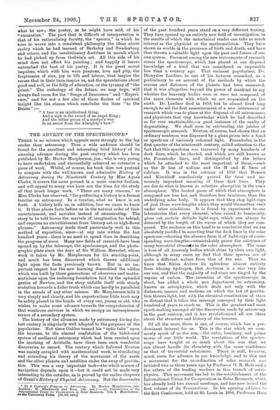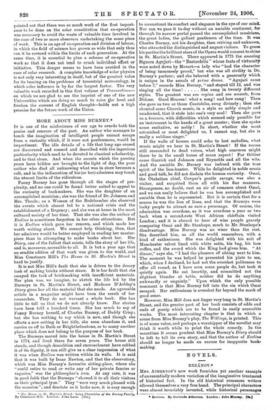THE ADVENT OF THE SPECTROSCOPE.*
THERE is no science which appeals more strongly to the lay reader than astronomy. Thus a wide audience should be found for the excellent and interesting brief history of its amazing advance during the past century which has been published by Mr. Hector Macpherson, jun., who is very young to have undertaken and successfully achieved so extensive a piece of work. Whilst, of course, his book does not pretend to compete with the well-known and admirable History of Astronomy during the Nineteenth Century by Miss Agnes Clerke, it covers the same ground in a more concise fashion, and will appeal to many who have not the time for the study of that much longer work. "There are many reasons," as Miss Clerke has observed, "for preferring a history to a formal treatise on astronomy. In a treatise, what we know is set forth. A history tells us, in addition, how we came to know it. It thus places facts before us in the natural order of their ascertainment, and narrates instead of enumerating. The story to be told leaves the marvels of imagination far behind, and requires no embellishment from literary art or high-flown phrases." Astronomy lends itself particularly well to this method of exposition, since—at any rate within the last hundred years—there is no need to spend time in describing the progress of error. Many new fields of research have been opened up by the telescope, the spectroscope, and the photo- graphic plate since the days of Sir William Herschel, whose work is taken by Mr. Macpherson for his starting-point, and much has been discovered which throws additional light upon the facts previously known. But in no im- portant respect has the new learning discredited the edifice which was built by three generations of observers and mathe- maticians upon the enduring foundation laid by the splendid genius of Newton, and the story unfolds itself with steady evolution towards a fuller truth which can hardly be paralleled in the annals of any other science. Mr. Macpherson tells it very simply and clearly, and his unpretentious little book may be safely placed in the hands of every one, young or old, who wishes to make some advance towards the comprehension of that wondrous universe in which we occupy an inconspicuous corner of a secondary system.
The history of the advances made by astronomy during the last century is singularly well adapted to the purposes of the populariser. Not since Galileo turned his "optic tube" upon the heavens, to the eternal confutation of the hidebound system of mediaeval astronomy which had been erected upon the teaching of Aristotle, have there been such wonderful discoveries to record. The century which followed Newton was mainly occupied with mathematical work, in elucidating and extending his theory of the movement of the earth and the other planets and satellites nnder the sway of gravita- tion. This was a very important task—the whole science of navigation depends upon it—but it could not be made very interesting to the outsider, as is proved by the earlier chapters of Grant's History of Physical Astronomy. But the discoveries • (1) 4 Centurjs Progress in Astronomy. By Hector Macpherson, jun. London W. Blackwood and Sons. [60. net.1—(2) Tramsacticnts of the International Union for Co-operation in Solar Research. Vol L Manchester: at the University Press. [7s. 6d. net.] of the past hundred years stand on a very different footing. They have opened up an entirely new field of investigation, in the results of which the untechnical reader can take as much interest as the physicist or the mathematician. They have shown us worlds in the processes of birth and death, and have thus thrown a valuable light upon the past and future of our own system. Foremost among the new instruments of research comes the spectroscope, which has placed at our disposal knowledge of a kind that was considered as impossible less than a century ago. That eminent populariser, Dr. Dionysius Lardner, in one of his lectures remarked, as a preliminary to an account of the methods by which the masses and distances of the planets had been measured, that it was altogether beyond the power of mankind to say whether the heavenly bodies were or were not composed of the same elements with which we are acquainted on the earth. Dr. Lardner died in 1859, but he almost lived long enough to se Ts the first announcement of a new instrument of research which was to place at the disposal of all astronomers and physicists that very knowledge which he had described as for ever unattainable,—a good instance of the vanity of dogmatising. We shall soon be celebrating the jubilee of spectroscopic research. Newton, of course, had shown that an ordinary sunbeam was dispersed by a glass prism into a band or spectrum of variously coloured light. Fraunhofer, in the first quarter of the nineteenth century, called attention to the fact that this spectrum was traversed by many hundreds of dark lines, which he charted, and which are still known as the Fraunhofer lines, and distinguished by the letters which he attached to the most important of them,—such as the D line of sodium and the H and K lines of calcium. It was in the autumn of 1859 that Bunsen and Kirchhoff conclusively proved the true and im- mensely important meaning of these dark lines. They are due to what is known as selective absorption in the sun's atmosphere. The heated gases of which that atmosphere is composed are less hot, and therefore less luminous, than the underlying solar body. It appears that they stop light-rays of just those wave-lengths which they would themselves emit under other conditions. It is found by experiment in our laboratories that every element, when raised to luminosity, gives out certain definite light-rays, which can always be detected by the length of the waves of which they are com- posed. The evidence on this head is so conclusive that we are absolutely justified in asserting that the dark lines in the solar spectrum—showing the absence from it of light-rays of corre- sponding wave-lengths—unmistakably prove the existence of many terrestrial elemeits in the solar atmosphere. The same is true of all heavenly bodies which shine by their own light, although in many cases we find that their spectra are of quite a different nature from that of the sun. Thus we know that Sirius derives its splendour almost entirely from blazing hydrogen, that Arcturus is a star very like our sun, and that the majority of red stars are tinged by the vapour of carbon. The invention of the spectroscope, in short, has added a whole new department to astronomy, known as astrophysics, which deals not only with the distances, masses, and motions on which the law of gravita- tion throws light, but with the chemical constitution of stars so distant that it takes the message conveyed by their light hundred of years to reach us. This is the greatest and most epoch-making amongst all the discoveries made by astronomy in the past century, and it has revolutionised all our ideas about the structure and history of the heavens.
Of all the stars, there is one, of course, which has a pre- dominant interest for us. This is the star which we com- monly speak of as the sun,—the ruler, luminary, and prime mover of our little world. The revelations of the spectro- scope have taught us so much about the sun that we can almost handle its chemistry with the same confidence as that of terrestrial substances. There is still, however, much room for advance in our knowledge, and to this end a movement for the co-ordination of solar research was initiated two or three years ago by Professor G. E. Hale and a. few others of the leading workers in this branch of astro- physics. This movement has led to the establishment of the International Union for Co-operation in Solar Research, which has already held two annual meetings, and has now issued the first volume of its Transactions. In his opening address to the first Conference, held at St. Louis in 1904, Professor Hale pointed out that there was so much work of the first import- ance to be done on the solar constitution that co-operation was necessary to avoid the waste of valuable time involved in the case of two or more observers undertaking the same piece of work. This is an age of co-operation and division of labour, in which the field of science has grown so wide that only thus can it be covered within the limits of each generation. At the same time, it is essential to plan a scheme of co-operative work so that it does not tend to crush individual effort or initiative. This danger seems to have been avoided in the case of solar research. A complete knowledge of solar physics is not only very interesting in itself, but of the greatest value for its bearing on the problems of terrestrial meteorology, in which solar influence is by far the largest factor. The very valuable work recorded in this first volume of Transactions— on which we are glad to see the imprint of one of the new Universities which are doing so much to raise he level and freshen the current of English thought—holds out a high promise for the future work of the Union.















































 Previous page
Previous page